Gone are the days of rigid 9-to-5 workdays and stay-at-your-desk work culture. A recent Bureau of Labor Statistics study indicates 23% of full-time employed workers did some or all of their work from home. Additional research by GlobalWorkplaceAnalytics.com suggests that 50% of the workforce holds a job that is compatible with at least partial telework and approximately 20-25% of the workforce teleworks with some frequency.
With remote work increasing, the need for managers, executives, and IT administrators to conduct a recurring remote meeting with key team members from around the state, across the nation, or in different countries has become increasingly common.
But what can you do as a manager to create a remote meeting environment where everyone is inspired to develop as individuals, take on added responsibilities, and work together as a team?
Take a look at the dos and don’ts of the remote meeting. Learn how to keep off-site employees both engaged and productive and discover some of the proven techniques to better ensure that all involved parties understand your organization’s unique workflow.
Setting the stage for communication and trust
Making telecommuting work for an entire team or department depends on keeping everyone connected through a cohesive communication network. And it involves more than technology.
It takes real commitment to establish an atmosphere of open communication and mutual trust.
After all, giving and receiving feedback is difficult enough in person, let alone via remote conference. Ensuring team members know what is expected of them and showing them appreciation for what they accomplish is not easily captured through remote meetings.
1. Clarify team expectations
When establishing rapport and building trust with employees through remote meetings, it’s important to let your team know what’s actually expected of them. Working remotely is still a relatively new concept for some people. And everyone on the team should understand the company’s policy in order to do their jobs effectively and efficiently.
For example, you might ask each team member to:
- Find a dedicated space from which attend meetings in an effort to minimize distractions.
- Add your working hours to your calendar so co-workers can schedule meeting times that accommodate everyone’s schedules.
- Set notifications to ensure that you arrive to meetings on time.
- Sync your calendar with the company’s messaging platform or change your status when in meetings.
- Mute your microphone when you’re not speaking to avoid background noise.
- Turn your video on.
- Keep focused on the meeting by minimizing browser windows and turning notifications off.
- Use the “Raise Hand” feature or chat to interject or ask questions in larger meetings.
- Feel free to jump in and participate at any time with smaller meetings.
You can even involve your team members in this discussion—create a team charter and allow team members to contribute rules or norms that they expect each other to follow. This process will establish greater buy-in for the agreed-upon rules. Get started with the template below, and use Lucidchart to record ideas in real time.
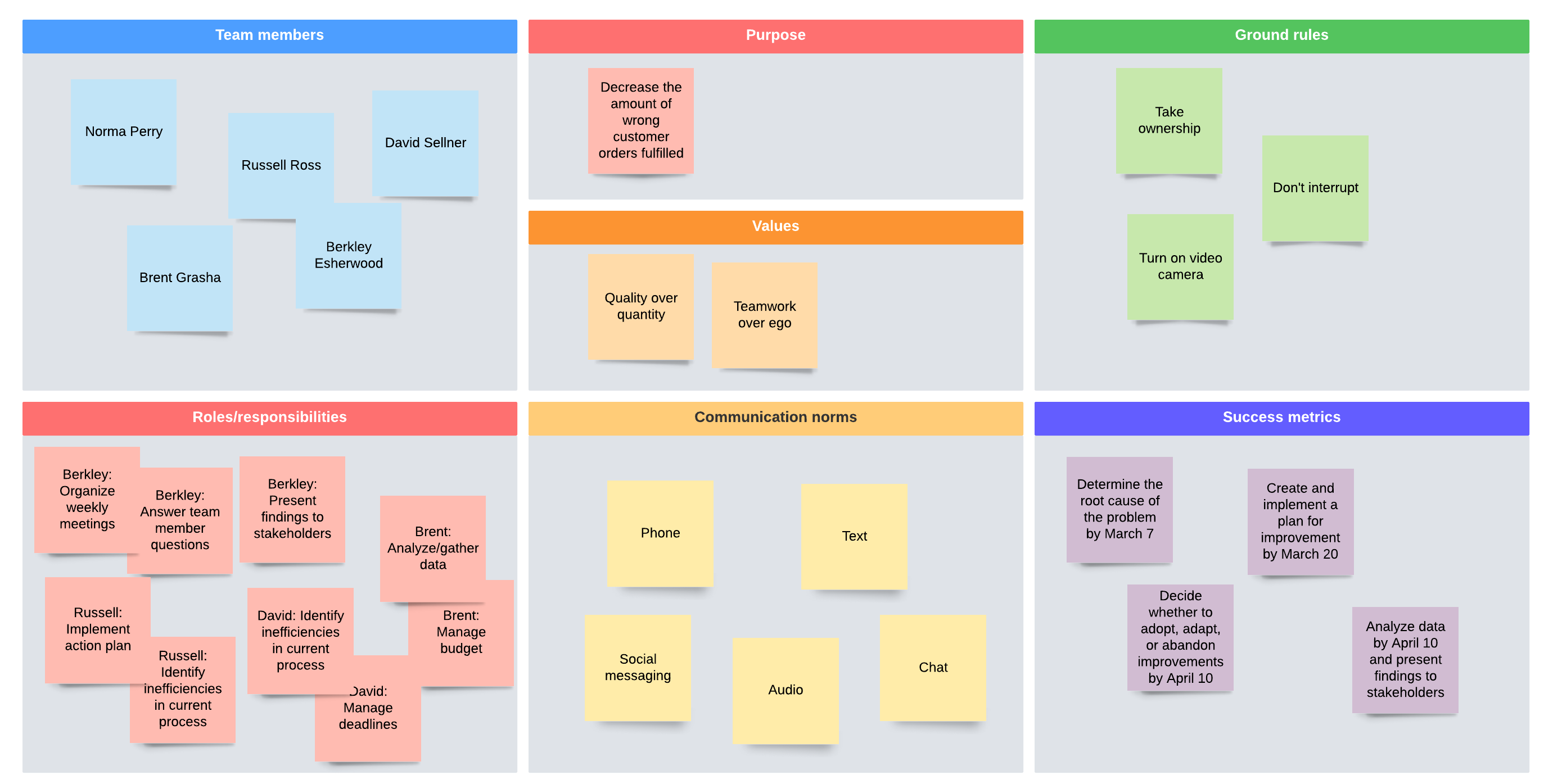
2. Schedule remote meetings in a way that matches your team dynamic
When managing remote employees, do you make a point of setting up regular weekly meetings with mandatory attendance? Or do you take a less formal approach—allowing employees who work remotely to simply check in and provide updates on their own? Are your expectations of those who work from home or outside of the office any different from the expectations you have for the employee who works with you directly?
Depending on your work style or team dynamic, any of these approaches is fine. The basic premise is to have some sense of expectation or structure in place for your team.
Some managers feel the need to schedule additional check-ins to make sure their remote team members stay productive and have the resources they need. While some team members might need the additional support, others could feel overburdened and micromanaged by this tactic. So resist that urge—talk to your team first about a cadence that works for them.
On the other hand, the defined start and end times of a scheduled meeting help provide needed structure and a sense of priority for people working from their home offices. Scheduling formal meetings ahead of time also shows respect for your co-workers’ time as opposed to asking for their attention at the last moment.
Set an expectation that works for your team. For example, if team members have an important topic to discuss or sync about, ask them to schedule formal meetings, but note that if you just have a quick question, it’s appropriate to just give a team member a quick call. Think of it as walking over to their desk if you were sharing a workspace.

Consider the downsides of too many meetings and ways that you can cut back meetings in order to increase productivity.
Read more3. Send out an agenda beforehand
While it’s wise to create an agenda for every meeting you host, this practice is especially important when you have multiple—or all—team members working from home.
A team meeting agenda provides the context for that calendar invite that more often than not appears out of nowhere, so attendees know what they need to do to prepare and what everyone hopes to get out of the meeting. It also encourages better team participation. Co-workers can add items they would like to discuss and see the value they will personally gain by attending the meeting.
As part of creating the agenda, you should also decide ahead of time who will facilitate the discussion (likely the person who called the meeting) and who will take notes.
Encouraging employee collaboration and participation
As you’ve led remote meetings, have you ever felt like members of your team are not paying attention or that they are distracted by incoming messages or whatever’s happening at home? The best way to counteract this issue is by asking employees to participate. Strive to keep every remote meeting collaborative and engaging for your employees.
With cloud-based platforms like Lucidchart or Google Docs, remote and on-site employees alike can collaborate on projects together in real time—automatically seeing each other’s changes and responding with insightful comments. All without having to be in the same location or time zone.
Remote meetings might currently be the exception to your everyday work experience. But as more businesses and corporations adopt a flexible workforce model, your skill for inspiring employee collaboration and participation will become essential.
4. Take advantage of video conferencing
According to Harvard Business Review, 87% of remote workers feel more connected through the use of video conferencing. Participants in this form of virtual team meeting benefit from seeing one another’s facial expressions and mannerisms, picking up on the visual cues and subtleties otherwise missed when limited to a speakerphone conversation or reading through an extensive email chain.
When conducting your remote meetings as a video conference, take advantage of what’s really possible with the format. Share presentations and get real-time feedback from your team. Use it to livestream any events that remote employees otherwise can’t attend, such as quarterly all-hands meetings or training workshops. For team members who are unable to participate live, make recordings of the video meeting that can be shared for viewing at a later time.
5. Leave time for water cooler conversations
A disadvantage to working remotely, as opposed to working in the same office as your team, is that there are fewer casual opportunities for team members to bond and get to know one another.
During regular team meetings, such as a daily standup or sprint planning, use the first few minutes to catch up on any exciting news or weekend plans. In addition to bringing the team closer together and increasing employee satisfaction, this virtual water cooler chat can get team members prepared to participate more during the meeting.
Does your agenda usually take up the entire meeting time? Consider scheduling the occasional sync just to catch up as a team or to plan a virtual team building activity.
6. Use a digital whiteboard to give team members a chance to participate without scrutiny
It can be uncomfortable to speak up with your ideas during a video conference—because you can only hear one person clearly at a time, it can feel like everyone is staring directly at you, and you run the risk of talking over another co-worker.
To encourage greater participation and involve multiple people, use a digital whiteboard. Pose a question, ask team members to brainstorm and drop in sticky notes with their ideas, and then organize those sticky notes by theme or priority.
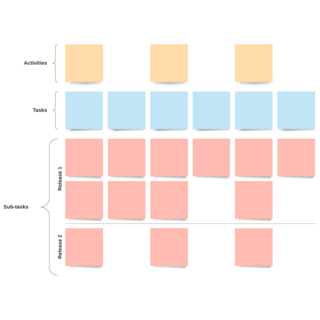
See helpful tips for using Lucidchart as your digital whiteboard.
Learn more7. Incite healthy debate over ideas
It’s the ability to manage conflicting tensions—rather than always seeking cohesiveness—that is the most predictive factor of team performance. Feeling comfortable enough to regularly debate and spar over ideas can actually be productive. A six-year study of group dynamics in 55 teams revealed a 22% better performance for those who allowed conflict as opposed to those teams that always agreed.
Conducting successful team meetings remotely will always be a learning process. Fortunately, the experience of remotely managing a team will allow you to build more trust and camaraderie with your employees than may otherwise be possible in a traditional office setting.
8. Be a better listener
We’ve all been in those meetings where a few people dominate the conversation. Whether the meeting is remote or not, try to be a better listener by being the last one to speak. Not only does it encourage greater team participation; it may allow you to learn something new.
As leadership expert Simon Sinek explains, “The skill to hold your opinions to yourself until everyone has spoken does two things: One, it gives everybody else the feeling that they have been heard. It gives everyone else the ability to feel that they have contributed. And two, you get the benefit of hearing what everybody else has to think before you render your opinion.”
If you manage a team or lead a virtual meeting, you should also look out for the team members who are less likely to speak up. You may want to directly ask them for their input with a simple “How do you feel about that?” or “Based on your past experience, is there anything you would change?”
With the right encouragement, your remote employees will begin to feel more comfortable in voicing their opinions, sharing their insights, and becoming active participants in team matters.
9. Clarify action items
Make sure that you have created action items and documented them on the agenda (along with the assigned team member) for future reference. It might seem redundant, but it’s a great practice to review these action items before the end of the meeting to ensure each team member understands their role and is held accountable for deliverables.
If you’re running low on time, facilitators can also send a follow-up email with the action items, and project managers may choose to visualize the team’s progress through a project dashboard.
Providing support beyond the remote conference call
The work typically doesn’t end with the meeting—there are a few steps that managers can take to give remote team members the resources they need and keep them from feeling siloed as they complete action items.
10. Refine and document your internal processes
Staying in touch with remote employees by email, text, instant messaging, phone calls, and virtual team meetings is a start. But what the entire team really needs is a shared understanding of how processes work and how responsibilities are divided up.
Remote employees need a clear picture of the workflow process. Creating such a process flow can help standardize how work gets done, what steps must be taken, who makes the approvals, and when a project is finally complete. Without an outline to follow, remote employees can experience unnecessary frustration.
With Lucidchart, managers can quickly outline workflows with a high-level diagram to make sure everyone understands the procedures for their organization. Lucidchart makes it easy to provide everyone with access to the team’s process flow. When your remote employees complete tasks or make updates to their work, they can export it or publish a live link—keeping everyone on the team informed and always aware of the current state of a project in real time.
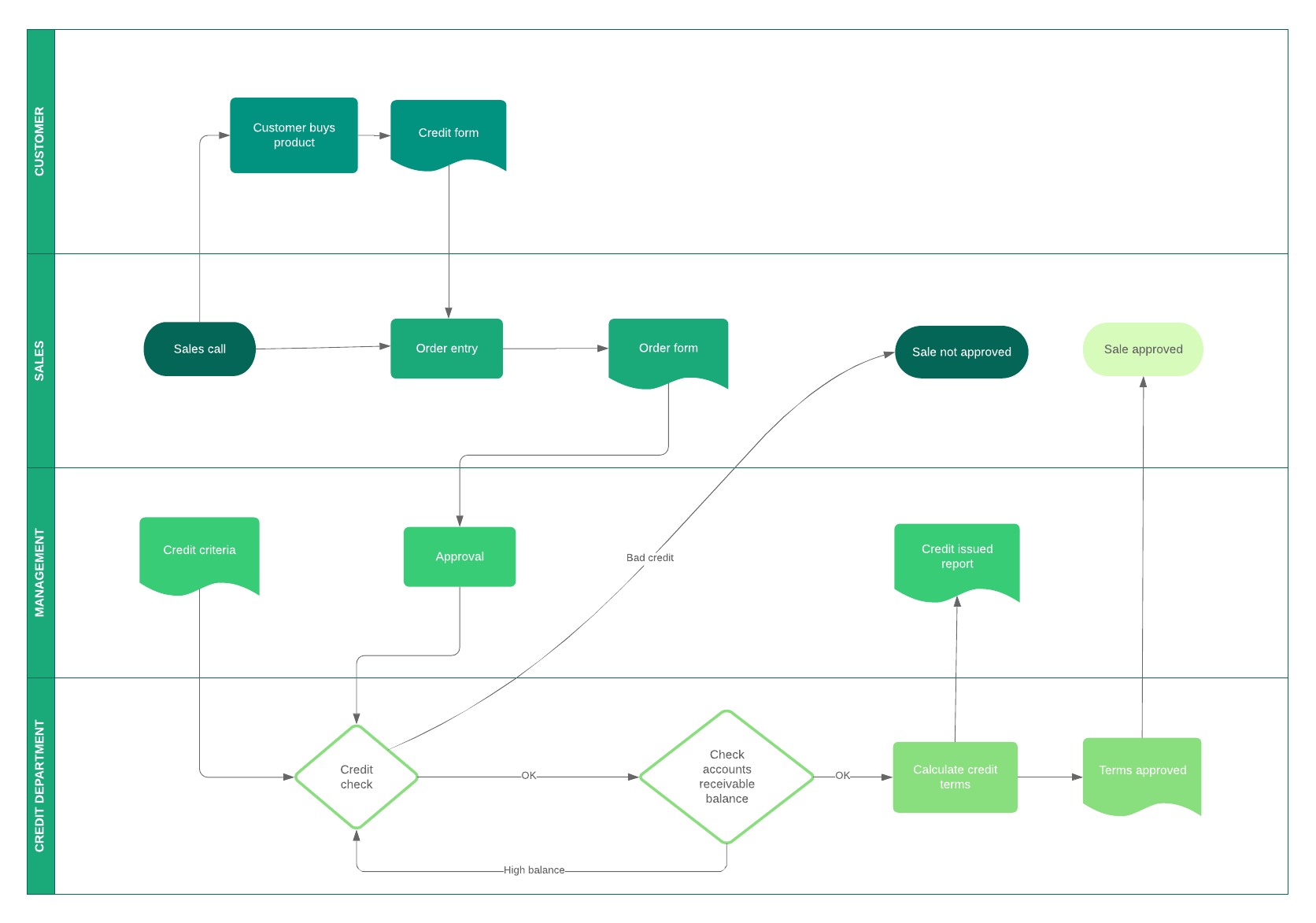
Depending on the nature of your work or the type of goods or services your company produces, real-time awareness can reduce duplication of work. It can also ensure that team members only reference the latest version of any project that is collectively being worked on.
The diagrams you can create may even prove helpful for training new team members or when used as a point of reference when completing performance reviews with remote employees.
11. Talk regularly with each employee
Remote meetings aren’t limited to just groups: When managing a remote team, you should schedule time to speak one-on-one with each team member at least once a week.>
And not just about work. Even taking the first few minutes of the conversation to understand what’s going on in their lives before talking shop can help establish deeper connections and open the lines of communication for the team.
For suggestions on topics to cover, check out our customizable 1:1 meeting agenda.
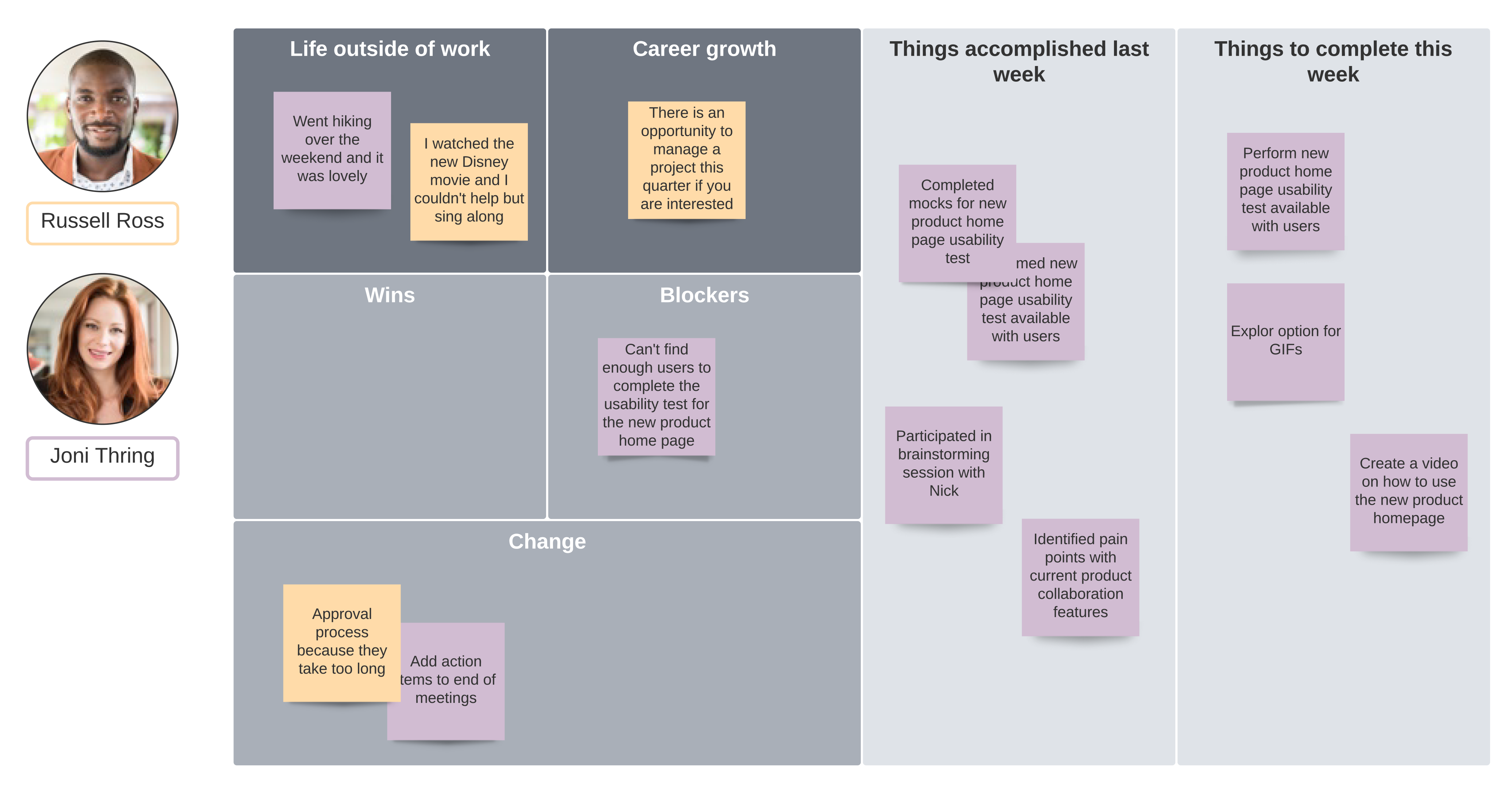
12. Highlight team accomplishments
When working remotely, there are fewer opportunities to congratulate team members on a job well done and to show them how their work makes an impact on the company overall. And that recognition is critical to employee satisfaction. Take time out of your remote team meetings to acknowledge recent accomplishments and wins.
Making remote meetings better with Lucidchart
The combination of technology and well-defined objectives can go a long way to keeping remote employees happy, engaged, and productive. Whether you seek ideas to make your virtual team meetings more dynamic or need an easier way to outline your organization’s workflow, Lucidchart has the tools and resources it takes to achieve your loftiest goals.
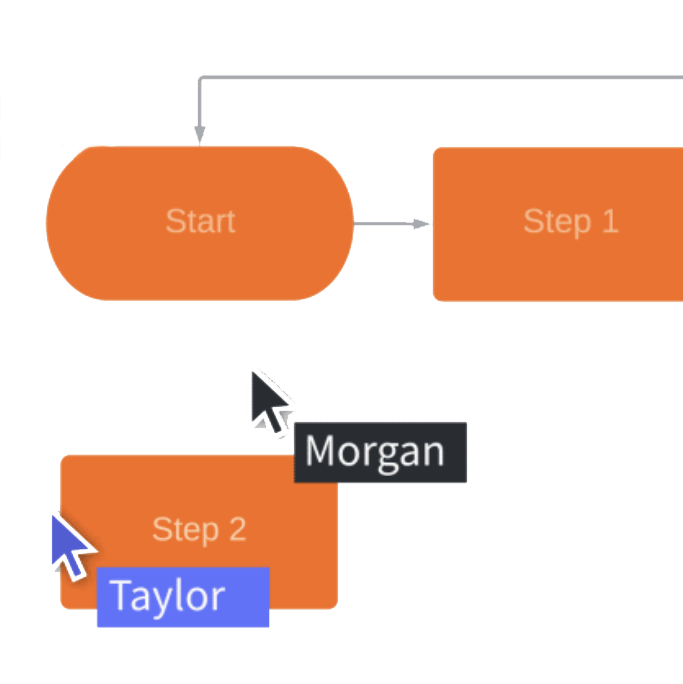
In Lucidchart, you can bring remote teams together to brainstorm, align on processes, and work together in real time.
See howAbout Lucidchart
Lucidchart, a cloud-based intelligent diagramming application, is a core component of Lucid Software's Visual Collaboration Suite. This intuitive, cloud-based solution empowers teams to collaborate in real-time to build flowcharts, mockups, UML diagrams, customer journey maps, and more. Lucidchart propels teams forward to build the future faster. Lucid is proud to serve top businesses around the world, including customers such as Google, GE, and NBC Universal, and 99% of the Fortune 500. Lucid partners with industry leaders, including Google, Atlassian, and Microsoft. Since its founding, Lucid has received numerous awards for its products, business, and workplace culture. For more information, visit lucidchart.com.
Related articles
[Infographic] The Rise of Workplace Collaboration in 2019
While trying to gather insights on the challenges that face IT organizations today, we uncovered some pretty dramatic shifts in the workplace that necessitate a greater focus on workforce collaboration. Take a look at our infographic to learn more.
Benefits and challenges of remote workers
Thinking about switching to a remote working environment? Use this guide to examine the benefits working remotely can give employers and staff as well as the common challenges.

